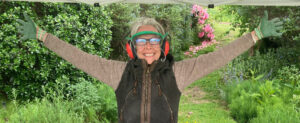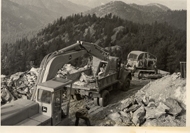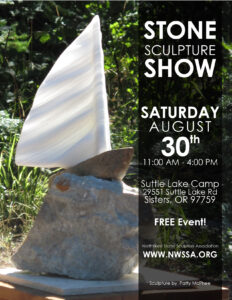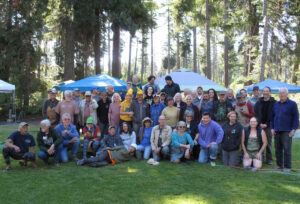
Home » Community » Legacy Members » John Pugh
I wish to thank all those who shared little tidbits of information with me about John. My special thanks go to Beverly Pugh. Her readiness to relate John stories on the phone with someone she’d never met says a lot about her gracious indulgence and her naturally helpful attitude. She never hesitated or put me off, but was always ready to talk, being patiently kind to me each and every time I called with yet another list of questions. Thank you, Beverly.

John Pugh 1936-2008
John was born in Carlton, Oregon in 1936 and graduated high school in the class of 1955 at the neighboring town of McMinnville. Well, almost. It seems that when they figured it all out, John was short half a credit, so while he marched along to the strains of Pomp and Circumstance with his classmates, he never got his diploma until he went back to school two years later and took a class, making up that missing half credit.
While still in his teens, John got a job with what was then called the Bureau of Public Roads, becoming eventually, the Federal Highway Administration. Working as a Civil Engineer/Technician, John became a trouble-shooter for sticky highway problems, the go-to man. Those of us who knew John would not be surprised at this. He was a fixer, the guy who could figure out how to make it work.
John Pugh retired from the Government, receiving what was literally called his “final departure” papers, on April 28, l989. He made his final departure from this mortal coil on April 28, 2008. The irony of this was not lost on Beverly, his wife of fifty-one years.
But this was not the full story of John’s life, not by a long way. There is that little thing about the discovery of steatite (soapstone) that brought such a huge change to John’s life and to that of his wife Beverly. It affected them both because they always worked side by side in the business.
But I’m getting ahead of myself. Before the steatite, came gold. One of the many things John got into while a government employee was underwater gold dredging. Busily working one day at his claim on Elliot Creek, the engine for his dredge blew a rod; there was nothing to do but hike back home to get tools and begin repairs. While taking that walk, John literally stumbled upon what was to become the Slide Gulch claim.

This claim yielded black and very dark green stone. John wondered if it might be saleable to the sculpture students at the University of Oregon In Eugene. At this point, his only vehicle for hauling stone from the claim to their home in town was Beverly’s burgundy Cadillac Coupe De Ville. It was just about at this time that John was made to see the wisdom of buying an old Willys Jeep for hauling rock.
It was l967, and the students, in those days, had to find their own stone. They bought the entire load from the first Willys trip, and many more after that.
Of course that wasn’t enough for John. He looked further afield and found more and better soapstone on and around the 200 acre mountain that he had to buy because he couldn’t get access any other way. The mountain was south of Grants Pass, Oregon and across the Applegate River; his son, Steven, says, “You can throw a rock into California from here.” These claims were named Hard Pull 1, 2, 3, etc and produced the lovely stuff that was 95% talc and certified asbestos free.
John began to stock-pile stone. Some guy from Alaska wanted it. Germany wanted it. Canada ordered hundreds of tons of it, shipping it north on the railroad. For the Canadian contract, John took an eight-month leave-without-pay from his government job. Things were going fine until a carload was lost in a train derailment. The short version of that story is that the Canadian contract was terminated in l979, putting John back on the payroll of his government road-work job.
He was traveling a lot now, working on, among other places, the Mt. St. Helens road wash out and Prince of Wales Island in Alaska. This was the period of time that John’s wife Beverly and son Steven ran the stone business, developing a market for carving kits. Each kit contained four 2 ½ X 3 X 4 inch, sawn stones along with 2 files, instructions and templates for a bear, a whale, a bull seal and a Ptarmigan. They sold thousands of them.
When John retired from the government in l989, he came back home to his beloved steatite mine. By then the business was booming. But as sometimes happens, father and son did not work well together and Steven left the business in l995.

In 1990, NWSSA member Marge Hunt stopped in Grants Pass to buy stone from John, and told him about our first ever symposium at Camp Brotherhood. The Board invited him to Camp B that year to sell tools and a variety of stone including his own soapstone. John continued with us annually, adding the first Silver Falls symposium to his list in 1994.
When John could no longer manage the trips, he put us together with Art City in Ventura, California to sell at all three of our workshops. He also introduced many of us to Trow & Holden Tool Company, and to a beautiful variety of high quality stone. John was a great resource to us in so many ways.
In l998 John went to the hospital with a severe case of pneumonia. Following a lengthy treatment regimen, he went back to cutting soapstone, continuing for another three years until poor health forced him to stop.
After a long battle, John finally succumbed to Cancer on April 28, 2008. Those of us, who knew him, will never be able to work a particularly fine piece of steatite or a soft and silky piece of soapstone without fondly remembering our friend, John, who brought a lot of it, and so much more, into our lives. With a twinkle in his bright blue eyes and his warm smile, John was an integral part of many of our symposiums. Thank you, John.
Remembering John Pugh article appeared in the July/August 2008 Issue of Sculpture NorthWest Journal









We need some kind of descriptive text here.